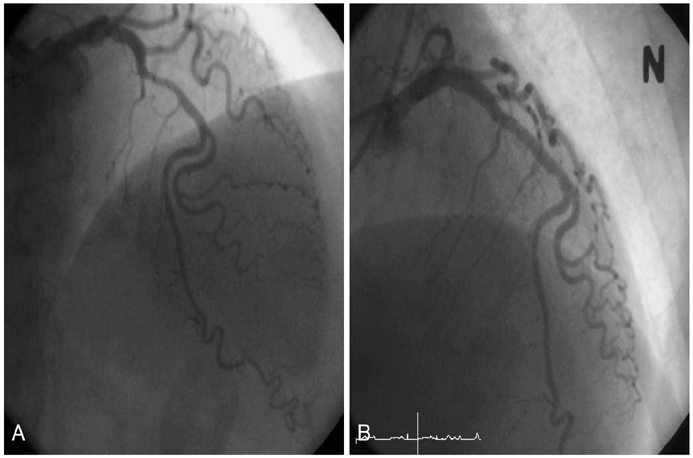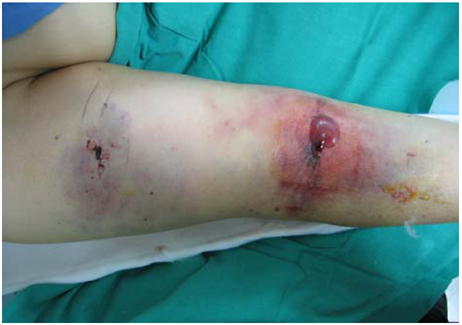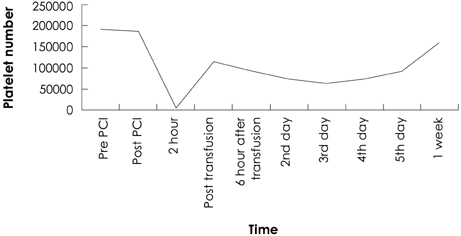Korean Circ J.
2007 Nov;37(11):594-598. 10.4070/kcj.2007.37.11.594.
A Case of Abciximab Induced Acute Profound Thrombocytopenia Resulting in Compartment Syndrome of the Forearm from Massive Bleeding at the Brachial Artery Access Site
- Affiliations
-
- 1Department of Internal Medicine, Vision 21 Cardiac and Vascular Center, Ilsan-Paik Hospital, Inje University College of Medicine, Goyang , Korea. bada8281@naver.com
- 2Department of Clinical Pathology, Ilsan-Paik Hospital, Inje University College of Medicine, Goyang , Korea.
- KMID: 1909622
- DOI: http://doi.org/10.4070/kcj.2007.37.11.594
Abstract
- Abciximab is one of the glycoprotein IIb/IIIa receptor inhibitors, and it is known to be effective for preventing and treating the thrombotic complications of percutaneous coronary intervention (PCI). On the other hand, there is an increasing risk of hemorrhagic complications when using abciximab, especially in the case of abciximab-induced thrombocytopenia. Acute profound thrombocytopenia is a rare, but life threatening adverse reaction to abciximab, and it can even occur within a few hours of the first exposure. We report here on a case of 56 year-old woman who experienced massive bleeding of her brachial artery access site. This was caused by abciximab-induced acute profound thrombocytopenia after performing PCI concomitant with using abciximab.
MeSH Terms
Figure
Reference
-
1. Coller BS. Blockade of platelet GPIIb/IIIa receptors as an antithrombotic strategy. Circulation. 1995. 92:2373–2380.2. The EPIC investigators. Use of a monoclonal antibody directed against the platelet glycoprotein IIb/IIIa receptor in high-risk coronary angioplasty. N Engl J Med. 1994. 330:956–961.3. Makoni SN. Acute profound thrombocytopenia following angioplasty: the dilemma in the management and review of the literature. Heart. 2001. 86:E18.4. Topol EJ, Byzova TV, Plow EF. Platelet GPIIb-IIIa blockers. Lancet. 1999. 353:227–231.5. Fefguson JJ, Kereiakes DJ, Adgey AA, et al. Safe use of platelet GP IIb/IIIA inhibitors. Eur Heart J. 1998. 19:D40–D51.6. Keriakes DJ, Berkowitz SD, Lincoff AM, et al. Clinical correlates and course of thrombocytopenia during percutaneous coronary intervention in the era of abciximab platelet glycoprotein IIb/IIIa blockade. Am Heart J. 2000. 140:74–80.7. Claeys LG, Berg W. Major bleeding and severe thrombocytopenia after combined heparin and abciximab-c7E3 Fab therapy. Eur J Vasc Endovasc Surg. 2003. 25:85–87.8. Christopoulos CG, Machin SJ. A new type of pseudothrombocytopenia: EDTA-mediated agglutination of platelets bearing Fab fragments of a chimeric antibody. Br J Haematol. 1994. 87:650–652.9. Jubelirer SJ, Koenig BA, Bates MC. Acute profound thrombocytopenia following C7E3 Fab (abciximab) therapy: case reports, review of the literature and implication for therapy. Am J Hematol. 1999. 61:205–208.10. Kim W, Jeong MH, Kim KH, et al. The rescue use of a patient glycoprotein IIb/IIIa receptor blocker in high risk patient with acute myocardial infarction underwent percutaneous coronary intervention. Korean Circ J. 2001. 31:492–499.
- Full Text Links
- Actions
-
Cited
- CITED
-
- Close
- Share
- Similar articles
-
- A case of acute profound thrombocytopenia following abciximab therapy
- Acute Dorsal Compartment Syndrome of the Forearm in a Patient with Rhabdomyolysis
- Acute Profound Thrombocytopenia after Using Abciximab for No-Reflow during Primary Percutaneous Coronary Intervention for ST-Segment Elevation Myocardial Infarction
- Thenar Compartment syndrome: A Case Report
- Idiopathic Compartment Syndrome of the Forearm








